Active primarily during the nineteenth century, Paul Gauguin (1848 – 1903) was a French artist who is now considered among the most important painters of the art movement Post-Impressionism, which extended Impressionism while rejecting its limitations; and laid emphasis on abstract qualities and symbolic content. Gauguin was not well appreciated during his time but rose in stature after his death. His experimentation with color and use of symbolism influenced modern art and he is considered among the most prominent figures of the Symbolist movement. Gauguin’s visits to Tahiti had an immense influence on his art. While his paintings of Tahitian subjects are among his most popular yet he is also seen as a colonial racist and misogynist by certain sections, due to which he remains a controversial figure. Know about the art of Post-Impressionist painter Paul Gauguin through his 10 most famous paintings.
#10 Mahana No Atua

| English Title: | The Day of the God |
| Location: | Art Institute of Chicago, U.S. |
| Year: | 1894 |
Paul Gauguin first moved to the French colony of Tahiti in 1891 in search of “ecstasy, calm, and art.” He spent most of his remaining life there. Many among Gauguin’s most famous masterpieces are paintings which are directly and symbolically inspired by the life, practices and people of Tahiti. This painting is divided into three horizontal bands. The top is dominated by an idol of the Tahitian mother goddess Hina with various rituals being performed for her. In the middle, three figures are placed on a field of pink earth, perhaps symbolizing the cycle of birth, life and death. The bottom section consists of dazzling and contrasting hues reflected in water in post-impressionistic style.
#9 Arearea
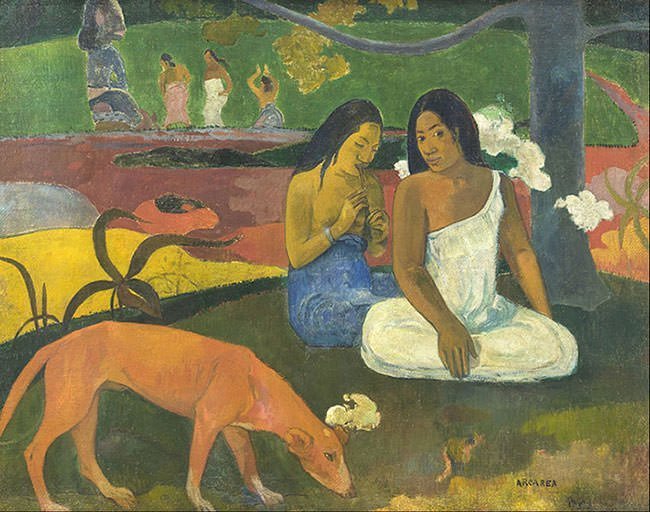
| English Title: | Joyousness |
| Location: | Art Institute of Chicago, U.S. |
| Year: | 1892 |
Paul Gauguin is known for works in which dream and reality coexist; and Arearea is a prime example. Two seated women take center stage in the painting with a red dog in front of them. In the background women are worshipping a Maori statue to create an imagery of an enchanted world. Arearea was not received enthusiastically when it was first exhibited with the dog especially provoking much sarcasm. Gauguin, however, considered it among his finest artworks and the painting is now among his most renowned masterpieces.
#8 Ia Orana Maria
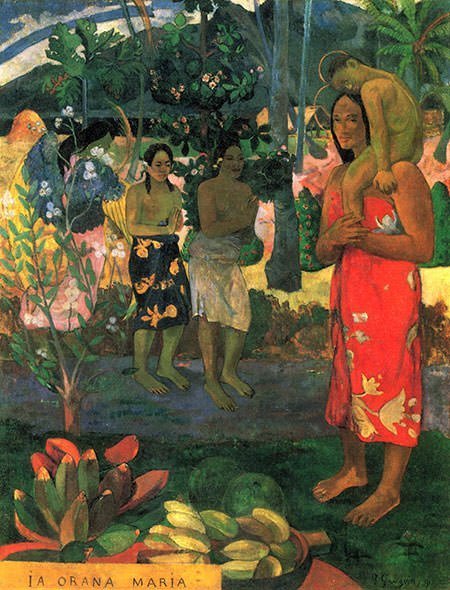
| English Title: | Hail Mary |
| Location: | The MET, New York City, U.S. |
| Year: | 1891 |
In one of his most acclaimed works, Gauguin combines his favored subject of faith with the deep influence he experienced during his visits to Tahiti. In the painting, Gauguin transforms the Christian figures of Virgin Mary and Jesus into a Tahitian mother and child. Two other women, with an angel by their side, bow to the mother and child in respect. Ia Orana Maria was well received when it was first exhibited and has since been considered among Gauguin’s best paintings.
#7 The Painter of Sunflowers
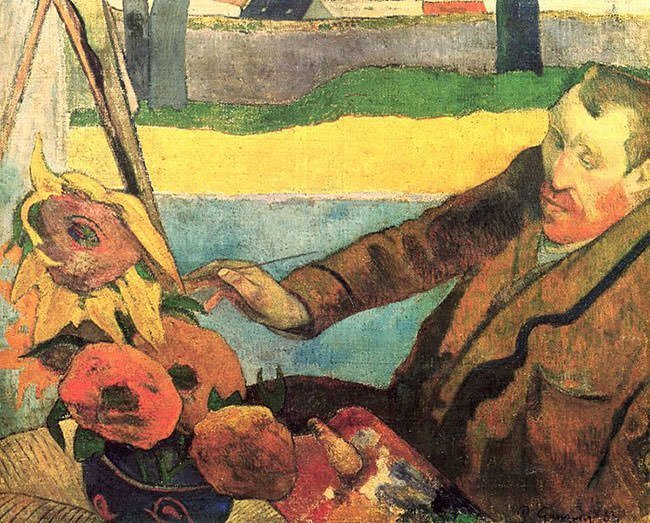
| French Title: | Le Peintre de Tournesols |
| Location: | Van Gogh Museum, Amsterdam, Netherlands |
| Year: | 1888 |
Paul Gauguin spent nine weeks painting together with Dutch artist Vincent van Gogh in 1888. Their time together was fraught with quarrels and culminated with Van Gogh famously cutting off his left ear. They never met again but continued to correspond. The relationship between Gauguin and Van Gogh has since been a subject of much examination and analysis. This portrait of Van Gogh, working on a piece of his renowned Sunflowers series, is Gauguin’s most famous work in portraiture.
#6 Vision After the Sermon (Jacob Wrestling with the Angel)
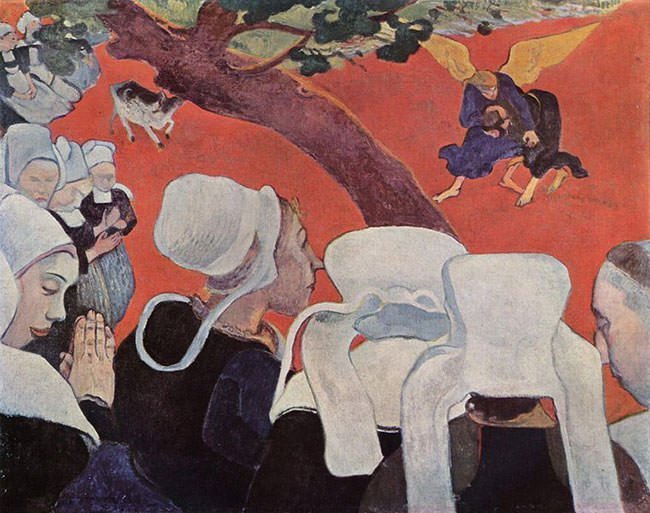
| French Title: | La Vision après le sermon |
| Location: | Scottish National Gallery, Edinburgh, U.K. |
| Year: | 1888 |
This painting depicts a scene from the Bible in which Jacob wrestles an angel. However the scene doesn’t take center stage in the artwork and is shown through the vision of women who have just attended a sermon in church. Gauguin structures the painting by placing a tree trunk diagonally through its center to create a visual separation between the Breton women and their vision. According to Gauguin the landscape and the fight only exists in the imagination of the women, who are praying after the sermon.
#5 Nevermore
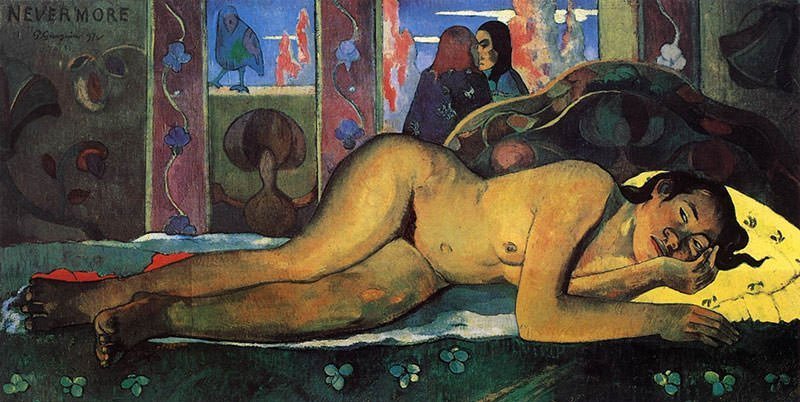
| Location: | Courtauld Gallery, London, U.K. |
| Year: | 1897 |
Gauguin created Nevermore at a time of stress due to the death of his daughter and financial difficulties. The painting is inspired by Edgar Allan Poe’s famous 1845 poem The Raven, which tells the story of a talking raven’s visit to a distraught lover who is lamenting the loss of his love. The raven instigates the lover’s distress with its constant repetition of the word “Nevermore” and he falls into madness. Gauguin’s painting shows a Tahitian girl in an awkward pose with an expression of poetic sadness perhaps lamenting the physical or symbolic death of someone or something. Like in many of his paintings, Gauguin simultaneously represents reality and illusion adding to the mystery of the artwork. Nevermore is considered among his most philosophically and poetically rich works. It was voted Britain’s most romantic painting in a poll conducted by The Art Fund charity.
#4 When Will You Marry?
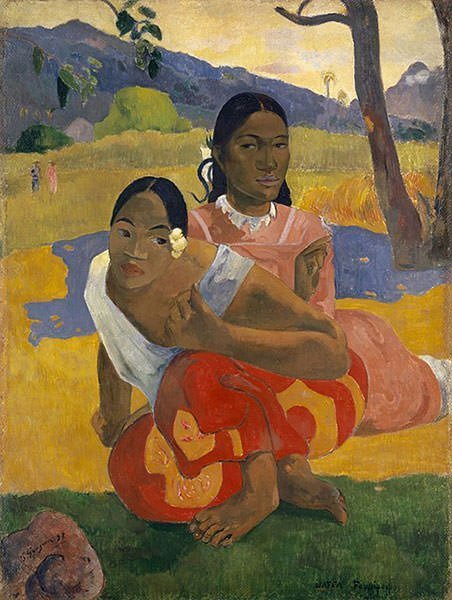
| Tahitian Title: | Nafea faa ipoipo |
| Location: | Private Collection |
| Year: | 1892 |
Paul Gauguin painted several paintings of native women of Tahiti dressed in traditional Tahitian attire and western dresses. They are among his most renowned artworks. This composition depicts a traditionally dressed woman and behind her is a woman wearing a high necked western dress. It can be inferred from the white tiare flower on the ear of the traditionally dressed woman that she is seeking a husband, hence the title. In February 2015, When Will You Marry? was sold privately by the family of Rudolf Staechelin to Sheikha Al Mayassa for close to US $300 million (£197 million). As of April 2016, this remains the highest price ever paid for a work of art, even after adjusting for inflation.
#3 The Yellow Christ
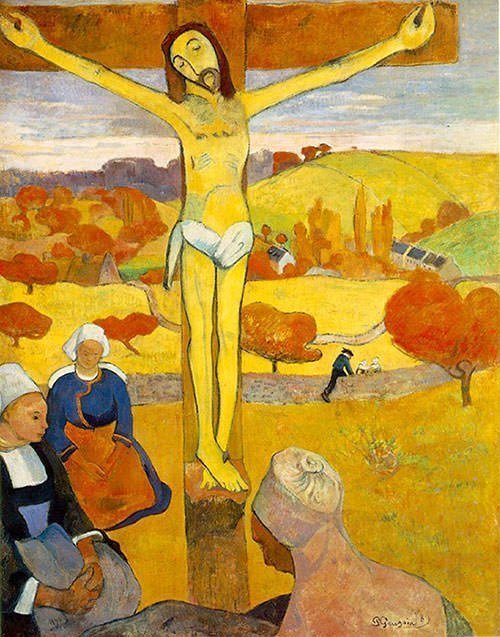
| French Title: | Le Christ jaune |
| Location: | Albright–Knox Art Gallery, Buffalo, New York, U.S. |
| Year: | 1889 |
Along with another painting by Gauguin titled The Green Christ, this painting is among the first and most important works of Symbolism in painting. The Yellow Christ shows the crucifixion of Christ taking place in 19th century northern France while women are gathered in prayer. The composition is noted for various symbolisms, like the man running in the background reflects the 19th century desire to run away from city life and get back to the “primitive”, and much simpler life that was before. It is his most renowned artwork before his years in Tahiti.
#2 Spirit of the Dead Watching
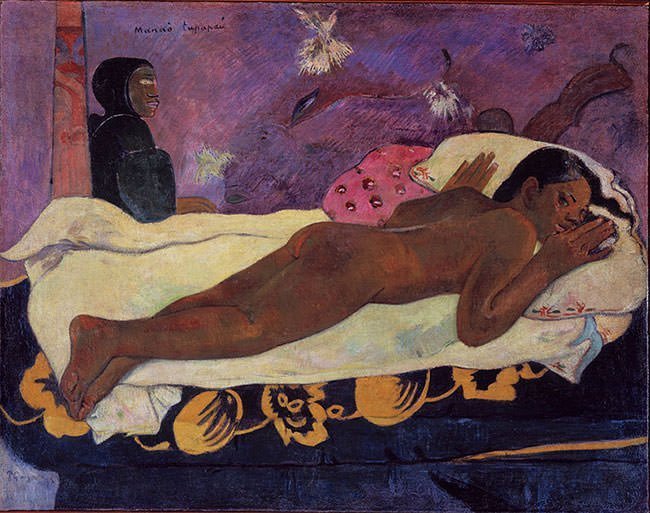
| Maori Title: | Manao tupapau |
| Location: | Albright–Knox Art Gallery, Buffalo, New York, U.S. |
| Year: | 1892 |
Paul Gauguin married a native woman named Teha’amana during his first visit to Tahiti. Gauguin returned home late one night and his young wife was startled with fear on seeing his figure appear from the darkness. According to Gauguin she mistook him for “one of those legendary demons or specters, the Tupapaus, that filled the sleepless nights of her people.” He was inspired by the incident to paint this extremely well known artwork which his supporters consider to be a masterwork of poetic suggestion, mystery and symbolism. However the painting is also infamous, especially among feminists, and has been called “a veritable encyclopedia of colonial racism and misogyny”.
#1 Where Do We Come From? What Are We? Where Are We Going?
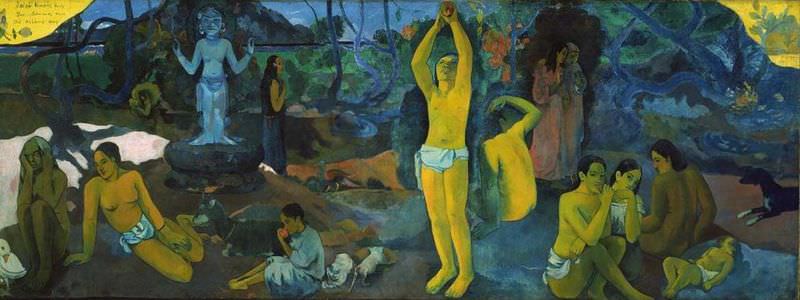
| French Title: | D’où Venons Nous / Que Sommes Nous / Où Allons Nous |
| Location: | Museum of Fine Arts, Boston, U.S. |
| Year: | 1898 |
The most renowned masterpiece of Paul Gauguin and one of the most famous paintings of Post-Impressionism, this artwork consists of three major figure groups illustrating the questions posed in the title. It is supposed to be read from right to left according to the artist. Gauguin was in despair when he undertook the painting due to the death of his daughter earlier that year. It is said he planned to take his own life after finishing it and even made an unsuccessful attempt. The painting is the most colossal canvas that Gauguin ever painted and it explains in detail his entire philosophical and pictorial doctrine. Even Gauguin regarded it as his best painting and the grand culmination of his thought.


It was a great memory and I remembered Gauguin. Thanks for sharing. A deserving artist to introduce to the grade six students.